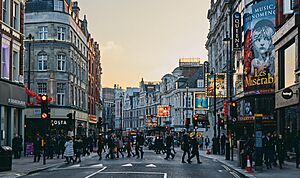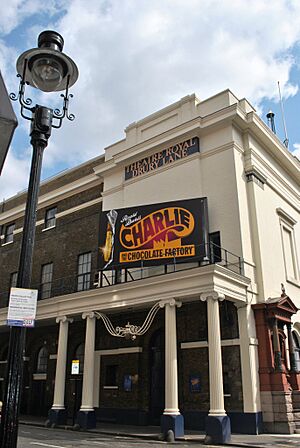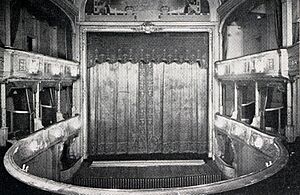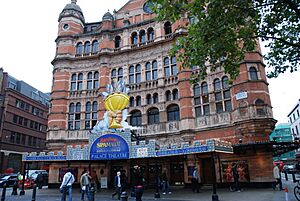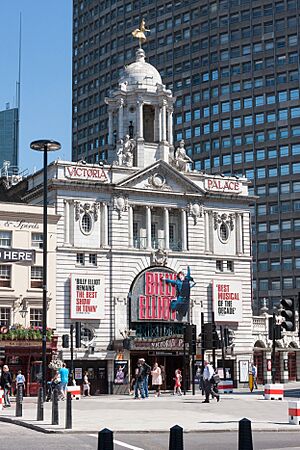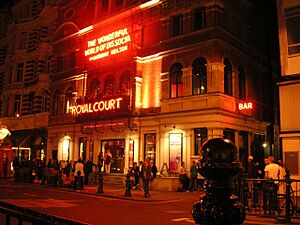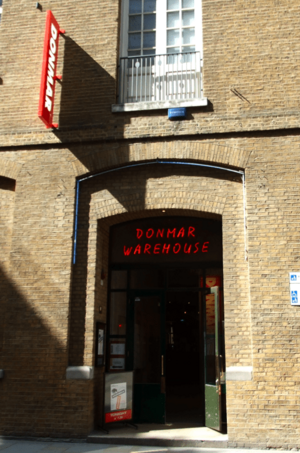West End theatre facts for kids
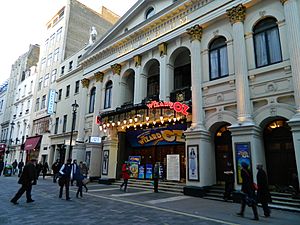
West End theatre means professional plays and musicals shown in the big theatres in and around the West End of London. It's like the top level of commercial theatre in the English-speaking world, similar to New York City's Broadway theatre. Many tourists visiting London love to see a West End show. Famous actors from movies and TV, both British and international, often perform on these London stages.
There are about 40 theatres in the West End. The Theatre Royal, Drury Lane, which opened in May 1663, is the oldest theatre in London. The Savoy Theatre was built to show the popular comic operas by Gilbert and Sullivan. It was the first public building in the world to be fully lit by electricity in 1881.
The Society of London Theatre (SOLT) shared that 2018 was a record year for London's theatre. Over 15.5 million people attended shows that year. Ticket sales brought in more than £765 million. In 2019, sales reached a new high of £799 million. By 2023, a record 17.1 million people watched West End shows.
Most West End theatres are owned by big companies like ATG Entertainment, Delfont Mackintosh Theatres, Nimax Theatres, LW Theatres, and the Nederlander Organization.
Contents
How West End Theatre Began
Theatre in London really grew after the English Reformation. The first permanent public theatre, called The Theatre, was built in 1576. It was in Shoreditch and built by James Burbage. Soon after, The Curtain theatre opened nearby. Both were used by William Shakespeare's acting group. In 1599, wood from The Theatre was moved to Southwark. It was used to build the Globe Theatre in a new area for theatres.
However, some people called Puritans thought theatre was wrong. They closed these theatres in 1642. Actors protested this ban in a pamphlet.
After the king returned to power in 1660 (called the Restoration), the rules against theatre were removed. Theatre and other arts became very popular again. Two main acting companies were allowed to perform. The first West End theatre, called Theatre Royal in Bridges Street, opened on May 7, 1663. It was designed by Thomas Killigrew. This theatre was later destroyed by fire. A new one, designed by Christopher Wren, was built in its place and named the Theatre Royal, Drury Lane. One of the first actresses on stage, Nell Gwyn, became a star.
Outside the main West End area, Sadler's Wells Theatre opened in 1683. It was a "Musick House" for operas, not plays. In the West End, the Theatre Royal Haymarket opened in 1720. The Royal Opera House opened in Covent Garden in 1732.
A famous musical play called The Beggar's Opera ran for 62 shows in 1728. This was a record for London for almost 100 years. Another musical show, Tom and Jerry, or Life in London (1821), was the first London show to reach 100 performances in a row. These shows helped lead to modern musical comedies.
For a long time, only a few special theatres could perform plays. Other theatres could only show musical acts. But in the early 1800s, music hall shows became popular. People found a way around the rules by performing "melodramas." These were plays with music, so they weren't breaking the law.
The West End theatre area grew as many smaller theatres opened. The Adelphi Theatre opened in 1806. The Old Vic opened south of the River Thames in 1818. The Theatres Act 1843 made it easier to perform plays. This led to even more theatres opening in the West End. The Adelphi hosted a play based on A Christmas Carol by Charles Dickens in 1844.
The Criterion Theatre opened in 1874. In 1881, the Savoy Theatre opened. It was built for the comic operas of Gilbert and Sullivan. It was the first theatre to be lit completely by electric lights. Five days later, the Comedy Theatre opened. In 1886, Alice in Wonderland had its first big show at the Prince of Wales Theatre. The author, Lewis Carroll, was involved in making the play. The Palace Theatre opened in 1891. In 1904, J. M. Barrie's play, Peter Pan, or The Boy Who Wouldn't Grow Up, opened at the Duke of York's Theatre.
Famous playwrights like Oscar Wilde had their plays shown in the West End. Actresses like Lillie Langtry and Ellen Terry became very well-known. The New Theatre opened in 1903 and later became the Noël Coward Theatre. Her Majesty's Theatre opened in 1897. It showed plays like George Bernard Shaw's Pygmalion in 1914. Many new theatres were built until around the First World War.
In 1930, Laurence Olivier had his first big West End success. Other actors like John Gielgud and Vivien Leigh also started their careers there. For a long time, the government censored plays. But in 1968, the Theatres Act 1968 stopped this censorship in the United Kingdom.
What is Theatreland?
"Theatreland" is London's main theatre area. It has about 40 theatres. It's in the middle of the West End of London. It stretches from the Strand in the south to Oxford Street in the north. Some theatres just outside this area are also considered "West End" theatres. Important theatre streets include Drury Lane, Shaftesbury Avenue, and the Strand. The shows here are mostly musicals, classic and modern plays, and comedy shows.
Many West End theatres were built in the late Victorian or Edwardian times. They are often beautiful buildings with grand designs. Their names, like Empire, Lyceum, and Palladium, show how grand they are.
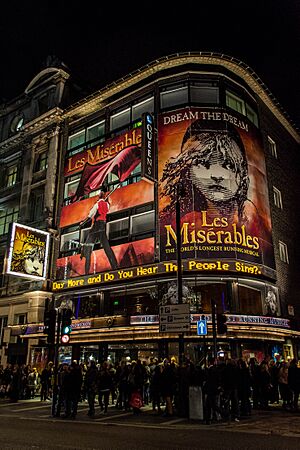
Because these buildings are old, the space for legs can be tight. Also, things like bars and restrooms are often smaller than in newer theatres. It's hard to make big changes because the buildings are protected and are in busy city areas. In 2003, experts said that £250 million was needed to update the theatres. They also said that 60% of seats in theatres didn't have a full view of the stage.
Since 2004, there have been times when plaster fell from ceilings. Shows were sometimes cancelled for urgent repairs. In December 2013, part of the ceiling at the Apollo Theatre fell. 76 people needed medical help. Some West End theatres have been updated. For example, the Victoria Palace Theatre was refurbished in 2017. The Dominion Theatre also finished its updates in 2017.
In 2012, ticket sales were over £529 million, and attendance was almost 14 million people. In 2013, sales went up to over £585 million, and attendance rose to over 14.5 million.
Due to the COVID-19 pandemic, all West End theatres closed on March 16, 2020. They were allowed to reopen with social distancing on May 17, 2021. Full capacity was allowed from July 19, 2021. The @sohoplace theatre opened in October 2022. It was the first new West End theatre in 50 years.
Long-Running West End Shows
The length of time a West End show runs depends on how many tickets it sells. The play The Mousetrap by Agatha Christie is the longest-running show in the world. It has been performed continuously since 1952.
The musical Les Misérables, produced by Cameron Mackintosh, is the longest-running musical in West End history. It has been running in London since October 1985. It took over from Andrew Lloyd Webber's Cats, which closed in 2002 after 8,949 performances over 21 years. Other long-running musicals include The Phantom of the Opera, Blood Brothers, and Mamma Mia!.
Matilda the Musical, based on Roald Dahl's book Matilda, has been running since 2011. It won a record seven Olivier Awards in 2012. Harry Potter and the Cursed Child, a two-part play based on a story by J. K. Rowling, has been running since 2016. It won a record-breaking nine Olivier Awards in 2017.
List of West End Theatres
Here is a list of some of the West End theatres. The table shows their address, when they opened, how many people they can hold, who owns them, and what show is currently playing.
| Theatre | Address | Opened | Capacity | Owner/Operator | Current production | Type | Opening | Closing |
|---|---|---|---|---|---|---|---|---|
| Adelphi Theatre | Strand | 1806 | 1,500 | LW Theatres / Nederlander Organization | Back to the Future: The Musical | Musical | 13 September 2021 | Open-ended |
| Aldwych Theatre | Aldwych | 1905 | 1,200 | Nederlander Organization | Tina—The Tina Turner Musical | Musical | 17 April 2018 | 13 September 2025* |
| Apollo Victoria Theatre | Wilton Road | 1930 | 2,328 | ATG Entertainment | Wicked | Musical | 27 September 2006 | Open-ended |
| Cambridge Theatre | Earlham Street | 1930 | 1,231 | LW Theatres | Matilda the Musical | Musical | 24 November 2011 | Open-ended |
| Dominion Theatre | Tottenham Court Road | 1929 | 2,163 | Nederlander Organization | The Devil Wears Prada | Musical | 5 December 2024 | Open-ended |
| His Majesty's Theatre | Haymarket | 1897 | 1,216 | LW Theatres | The Phantom of the Opera | Musical | 9 October 1986 | Open-ended |
| London Palladium | Argyll Street | 1910 | 2,286 | LW Theatres | Evita | Musical | 1 July 2025 | 6 September 2025* |
| Lyceum Theatre | Wellington Street | 1834 | 2,100 | ATG Entertainment | The Lion King | Musical | 19 October 1999 | Open-ended |
| Novello Theatre | Aldwych | 1905 | 1,146 | Delfont Mackintosh Theatres | Mamma Mia! | Musical | 6 April 1999 | Open-ended |
| Palace Theatre | Shaftesbury Avenue | 1891 | 1,400 | Nimax Theatres | Harry Potter and the Cursed Child | Play | 25 July 2016 | Open-ended |
| Prince Edward Theatre | Old Compton Street | 1930 | 1,727 | Delfont Mackintosh Theatres | MJ the Musical | Musical | 27 March 2024 | Open-ended |
| Prince of Wales Theatre | Coventry Street | 1884 | 1,148 | Delfont Mackintosh Theatres | The Book of Mormon | Musical | 21 March 2013 | Open-ended |
| Sondheim Theatre | Shaftesbury Avenue | 1907 | 1,137 | Delfont Mackintosh Theatres | Les Misérables | Musical | 8 October 1985 | Open-ended |
| St Martin's Theatre | West Street | 1916 | 550 | Stephen Waley-Cohen | The Mousetrap | Play | 25 November 1952 | Open-ended |
| Theatre Royal, Drury Lane | Catherine Street | 1663 | 1,996 | LW Theatres | Hercules | Musical | 24 June 2025 | Open-ended |
| Victoria Palace Theatre | Victoria Street | 1911 | 1,557 | Delfont Mackintosh Theatres | Hamilton | Musical | 21 December 2017 | Open-ended |
Upcoming Shows in West End
Here are some shows that are planned to open in the West End soon. The theatre for some of them might not be known yet, or another show might be playing there right now.
| Production | Type | Theatre | Opening |
|---|---|---|---|
| All My Sons | Play | Wyndham's Theatre | 14 November 2025 |
| Elf: The Musical | Musical | Aldwych Theatre | 28 October 2025 |
| The Importance of Being Earnest | Play | Noël Coward Theatre | 18 September 2025 |
| Paddington: The Musical | Musical | Savoy Theatre | 1 November 2025 |
| The Producers | Musical | Garrick Theatre | 15 September 2025 |
| Sleeping Beauty | Pantomime | London Palladium | 6 December 2025 |
Other Famous London Theatres
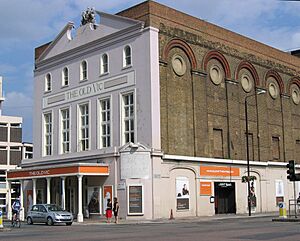
The term "West End theatre" usually means the commercial shows in Theatreland. But London also has other very important theatres that are not for profit. These include the National Theatre, the Barbican Centre, Shakespeare's Globe, the Old Vic, Royal Court Theatre, Sadler's Wells Theatre, and the Regent's Park Open Air Theatre. These theatres often put on serious plays, Shakespeare plays, and new plays by famous writers. Sometimes, successful shows from these theatres move to a commercial West End theatre for a longer run.
The Royal Opera House is known as one of the best opera houses in the world. It's often called Covent Garden because of its location. It is home to the Royal Opera, Royal Ballet, and a symphony orchestra. It also hosts performances from other opera and ballet groups from around the world. In 1735, its first season of operas by George Frideric Handel began there.
The London Coliseum is where the English National Opera performs. It's also the London home for the English National Ballet. The Peacock Theatre is near the Theatreland area. It is used for dance performances by Sadler's Wells.
Smaller London Theatres (Off West End)
There are many other stage shows in London outside the West End. This is often called fringe theatre or Off West End. It's similar to "off-Broadway" in New York City. Examples include the Menier Chocolate Factory, Bush Theatre, and the Donmar Warehouse. These smaller venues can be anything from well-equipped theatres to rooms above pubs. They show all kinds of performances, from classic plays to comedy. The performers can be new young professionals or amateurs. The Donmar showed the play Educating Rita in 1980, starring Julie Walters.
Many other theatres are located all over Greater London. Some examples are the Lyric Hammersmith, Theatre Royal Stratford East, and the Hackney Empire.
The Royal Polytechnic Institution (now the University of Westminster) showed the first public demonstration of "Pepper's ghost" in 1862. This was a way to make a ghost illusion appear on stage.
London theatres outside the West End also helped start drama schools. In 1833, actress Frances Maria Kelly ran a dramatic school at the Royal Strand Theatre. This was the earliest known drama school in England.
Theatre Awards
Each year, there are awards for great achievements in London theatre:
- Laurence Olivier Awards
- Evening Standard Theatre Awards
- WhatsOnStage Awards
- Critics' Circle Theatre Awards
- Ian Charleson Awards
- National Dance Awards
- West End Frame Awards
See also
 In Spanish: Teatros del West End para niños
In Spanish: Teatros del West End para niños
- Culture of London
- Great West End Theatres
- List of former theatres in London
- List of London venues
- Theatre of the United Kingdom
- List of Broadway theaters


